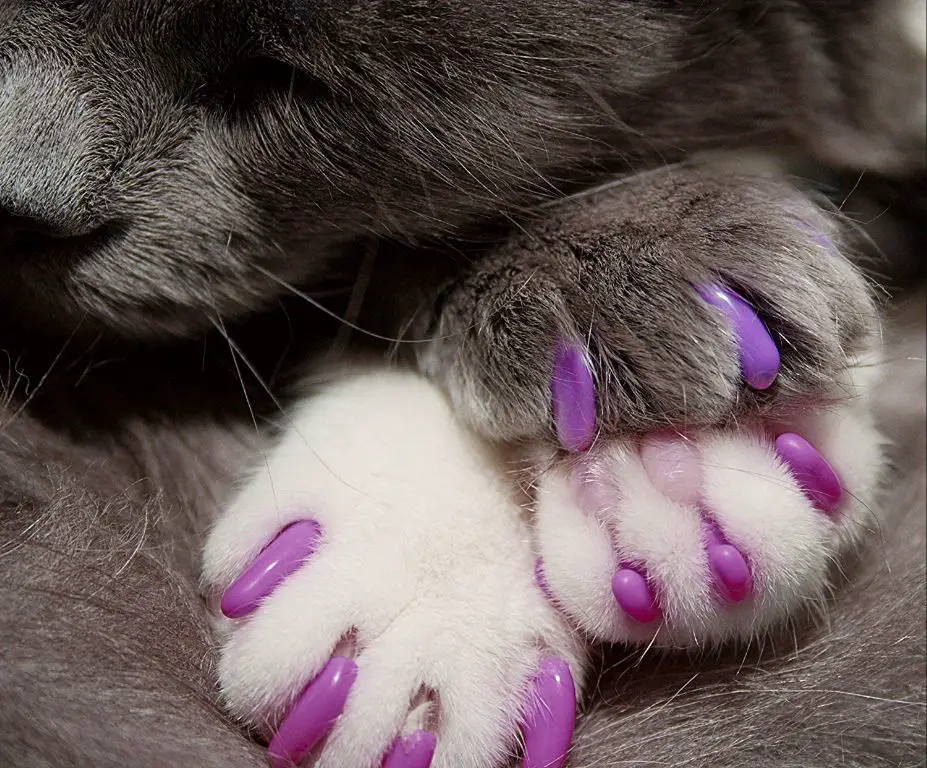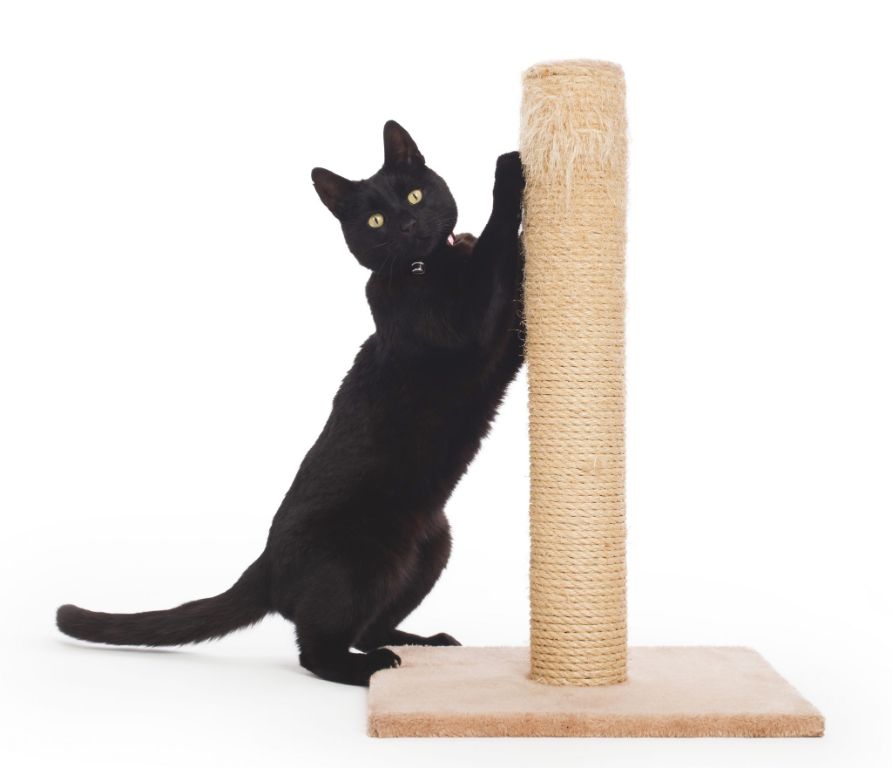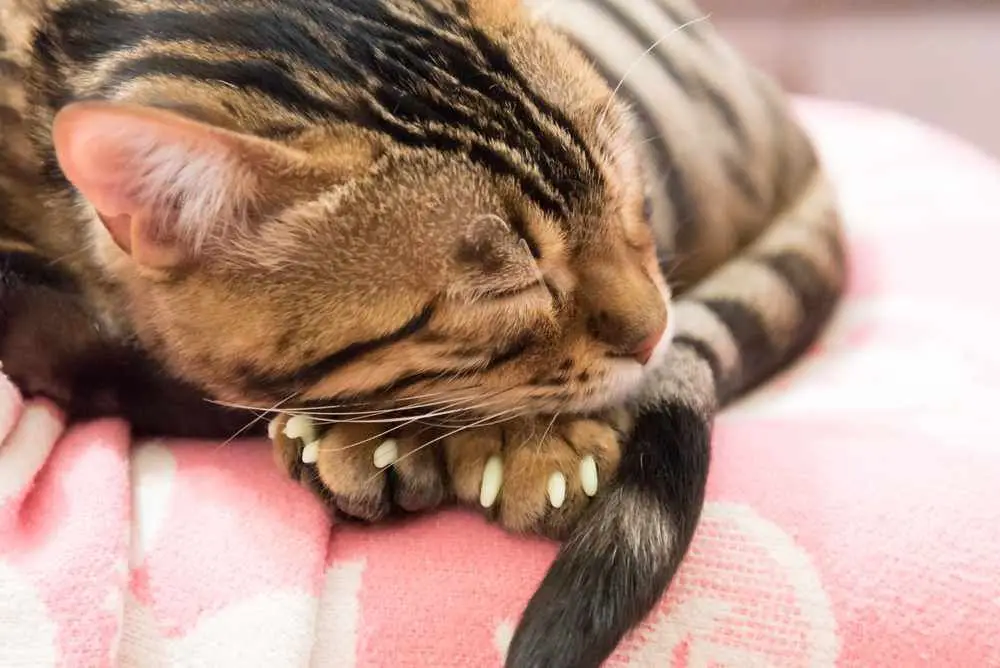What Are Cat Claw Caps?
Cat claw caps are small covers that fit over a cat’s claws to prevent damage from scratching. They are typically made of vinyl or plastic and come in various colors. Claw caps slide onto the end of the cat’s nail and are secured with a non-toxic glue.

Claw caps work by covering the sharp point of the claw so that when a cat scratches, no damage is done to furniture or flooring. The caps blunt the claws and prevent them from hooking into material. However, they don’t prevent a cat from enjoying normal scratching behavior.
There are a few types of cat claw caps:
- Soft claw caps have a flexible rubbery texture.
- Hard claw caps are made of rigid plastic.
- “Designer” claw caps come in colors or patterns for decoration.
The main pros of claw caps are protecting household items and avoiding declawing. The main cons are they require periodic replacement and some cats dislike having caps glued on. Overall, claw caps allow cats to satisfy their natural scratching urge without destructive clawing damage.
Why Use Cat Claw Caps?
Cat owners choose to use claw caps for several reasons, with protecting furniture and preventing destructive scratching being two of the main motivations. Claw caps provide a humane alternative to declawing, which is an extremely controversial procedure. According to the ASPCA, declawing involves “the amputation of the last bone of each toe” and can lead to physical and psychological complications for cats (source).
By covering the nails with caps, cats are still able to exhibit natural scratching behaviors without damaging furniture or other household items. The caps blunt the nails so that scratches do not penetrate surfaces. This allows cat owners to redirect scratching to appropriate surfaces like scratching posts without resorting to declawing or other punitive measures.
Claw caps are semi-permanent, lasting 4-6 weeks before needing replacement as the nails grow out. For cat owners struggling with destructive scratching, caps offer an effective and pain-free solution to curb damage and allow cats to satisfy their innate scratching instincts.
How Are Cat Claw Caps Applied?
Cat claw caps are applied by fitting the caps over the cat’s claws and securing them with an adhesive. The application process involves the following steps:
First, trim the cat’s claws if they are overgrown. The caps will not fit properly over claws that are too long. Use regular nail clippers designed for cats.
Next, open the package of nail caps and test fit them over each claw to find the right size for each claw. Nail caps come in different sizes to fit everything from kittens to large adult cats.
Fill the nail cap with a small amount of the accompanying adhesive using the applicator tip. Popular brands like Soft Claws provide the glue.

Gently push the filled nail cap onto the claw so it slides over the nail. Press down firmly to secure it in place and allow a minute or so for the glue to set.
Repeat the process until all claws are capped. Most brands recommend capping the back claws as well for full coverage.
The caps can be applied by veterinarians or cat owners at home. The glue is safe for indoor use. Owners should monitor the cat’s behavior after application in case they have issues adjusting.
The caps will stay on the constantly growing claw for 4-6 weeks before falling off. At that point, the owner can replace them with new caps.
Do Cats Tolerate Them?
Most cats adjust well to nail caps, though there is often an initial adjustment period. The caps may feel foreign at first, and some cats may try to chew or scratch them off. It’s important to closely monitor the cat during the first few days and distract them if they start biting at the caps. Some signs of discomfort include excessive licking, chewing, or shaking of the paws.
After a few days, the caps start to feel more natural as the cat acclimates. The adhesive wears down and smooths out any roughness or edges. As long as the caps are properly fitted and monitored, most cats tolerate them well. However, some sensitive cats may continue to overgroom or avoid using the scratched paws. If discomfort persists beyond the initial adjustment period, it’s best to remove the caps and try claw trimming or other alternatives instead.
To help cats adjust, start with just the front paws first. Wait a few days before capping the back paws. Only use nail caps if the cat is supervised and monitored closely. Pay attention to any signs of distress. While most cats do fine with caps after an initial transition, they are not the right solution for every cat.
Maintenance and Replacement
Cat claw caps typically last around 4-6 weeks before needing replacement, though some brands claim they can last up to 8 weeks before falling off on their own. According to Rover https://www.rover.com/blog/nail-caps-for-cats/, as the nail grows out, the caps will loosen and eventually fall off. This means the caps don’t need to be painfully ripped off when it’s time for a replacement.
It’s recommended to replace the caps every 4-6 weeks to maintain protection. The caps may fall off one nail at a time, so you may need to replace individual nails more frequently. Regularly check your cat’s nails and reapply caps as needed to avoid exposed claws. Establishing a routine schedule, such as replacing the caps every 4 weeks, can help ensure they are maintained properly.
Replacing the caps involves the same application process as the initial application. File and clean the nails, apply adhesive to the nail, fit the new cap on, and hold for 30 seconds until bonded. Provided the process remains stress-free for your cat, this regular maintenance should be relatively quick and painless.
Costs of Cat Claw Caps
The costs for cat claw caps can vary depending on the brand, where you purchase them, the size of claws needed, and how many claws you need to cover. However, on average most cat claw caps cost between $5-$15 for an initial kit that contains caps, adhesive, and applicators. Replacement adhesive kits cost $3-8 and include enough adhesive for about 4-6 applications.
Some factors that affect the cost include:
- Brand – Popular brands like Soft Claws and Soft Paws range from $7-$15 for initial kits whereas generic brands on Amazon are $5-$10.
- Purchase location – Buying directly from the manufacturer, at the vet’s office, or pet stores tends to be more expensive ($10-$15) than online discount retailers like Amazon ($5-$10).
- Cat’s claw size – Caps come in different sizes for small, medium or large claws. Larger sized claws require buying more caps which raises costs.
- Number of claws – Full sets range from 18-24 caps for front and back paws. But some owners just cap front paws or specific problem claws.
Overall, cat owners can expect an initial investment of $10-$15 for a starter kit and then $5-$10 for periodic replacement adhesive purchases every 4-6 weeks. Buying generic brands online and only capping problem claws can reduce costs. Vet application tends to be most expensive at $15-$25 every 4-6 weeks.
Source: Amazon.com Soft Claws Product Listing
Pros of Using Cat Claw Caps
There are several advantages to using cat claw caps:
One of the main pros is that claw caps prevent damage to furniture, carpets, drapes and other household items (Everything You Need to Know About Nail Caps For Cats – Rover.com). The vinyl caps cover the nails so when a cat scratches, no damage is done. This protects belongings without having to declaw the cat or restrict their natural scratching behavior.
Additionally, claw caps are considered a more humane alternative to declawing (Cat Nail Caps: Pros, Cons, and Alternatives to Consider – Great Pet Care). Declawing is an amputation procedure that removes the entire last bone of each toe. It can cause long-term physical and psychological problems. Claw caps allow cats to retain their natural scratching behavior without permanent medical alterations.
Cats can still scratch on scratching posts and surfaces to naturally shed their claw sheaths. The caps last 4-6 weeks before needing replacement as the nail grows out. This preserves normal scratching behavior while protecting household items.
Cons of Using Cat Claw Caps

While cat claw caps can help protect furniture, they do come with some potential downsides to consider before use:
Application Challenges: Putting on claw caps can be tricky, especially for first-time users. According to Petcarerx.com, “It takes time, patience and practice to properly apply claw caps.” The caps must be precisely fitted to each nail and securely glued in place, which can be difficult.[1]
Potential Discomfort: Some cats dislike having their paws handled or don’t tolerate the feeling of caps on their nails. The adhesive can also cause irritation in rare cases. Kittens and elderly cats may be especially sensitive. Owners should closely monitor for signs of distress.
Higher Maintenance: Claw caps only last 4-6 weeks before shedding off, so they require frequent replacement. Trimming claws is lower maintenance for most cat owners. Caps may fall off between applications, leaving nails exposed again.
While claw caps can protect furnishings, the application difficulty, potential discomfort, and higher maintenance compared to trimming are downsides for owners to consider.
Alternatives to Cat Claw Caps
There are several humane alternatives to cat claw caps that can help prevent damage from scratching without the need for caps:
Regular Nail Trimming
Trimming your cat’s nails every 1-2 weeks will blunt the sharp tips and reduce scratches. Use clippers designed for cats and avoid the pink quick area. Reward with treats after for positive reinforcement. [1]
Scratching Posts and Pads
Provide scratching posts and pads around your home so your cat has appropriate outlets for scratching. Place near furniture to divert scratching. Use different materials like sisal, cardboard, and carpet so your cat has options. [2]
Nail Filing
Gently filing your cat’s nails with an emery board or nail file can smooth sharp edges. Work slowly and give treats so your cat accepts this as a positive experience.
Declawing (Don’t Recommend)
Declawing should never be performed as it is inhumane, painful, and alters a cat’s abilities. There are many humane alternatives to stop unwanted scratching that don’t require permanent surgical alterations.
The Verdict
After reviewing the pros and cons, costs, and alternatives, cat claw caps can be an effective solution for protecting furniture and avoiding injuries from scratching when used properly and with care. The main points are:
- Claw caps are humane alternatives to declawing that allow normal nail growth.
- Cats generally tolerate caps well with introduction and positive reinforcement.
- Maintenance requires re-application every 4-6 weeks as nails grow out.
- Costs are reasonable at $10-15 per application.
- Claw caps prevent furniture damage better than alternatives like trimming.
- Risks include irritation, caps falling off, or chewing caps off.
Overall, claw caps seem to work well for many cat owners who use proper application and monitoring. Providing scratching posts, vertical scratchers, and cat trees can supplement caps. Check with your veterinarian before deciding if claw caps are right for your cat.


